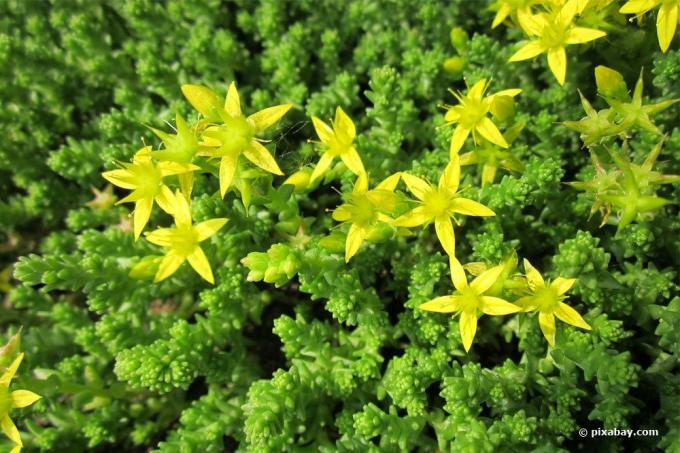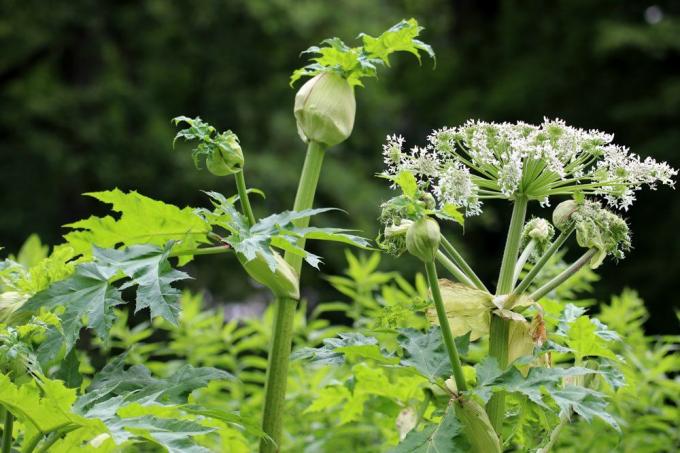
table of contents
- Explanation of terms: pointer plants
- 100 pointer plants presented
- Alkaline soils
- Calcareous soils
- nitrogen
- Acid soils
- Potassium indicator
- Humorous soils
- Sandy soils
- Clay soils
- Compacted soils
- dryness
- Damp soils to waterlogging
- Shadow and light pointers
- Metallophytes
- Saline soils
The flora is complex and some plants are designed differently to the natural conditions than others. A good example of this are the so-called indicator plants, which provide information about the quality and properties of the soil. Just by their presence, they reveal whether the soil is alkaline, moist or humic and only thrive poorly if the soil has a different texture.
Explanation of terms: pointer plants
Indicator plants can be seen as examples of soil quality. These are special species that have a certain ecological tolerance. The ecological tolerance or potency describes how well the species can withstand changes in the location. These include the following:
- Soil condition
- Amount of soil, air or water pollutants
- Amount of light
A pointer plant is therefore nothing more than a bio-indicator that can show you how the location or the direct environment affects it. If the condition changes from one day to the next, this has a negative effect on the plant, as its tolerance to the new properties is not high enough.
This is exactly why pointer plants are so important, because they can be used to make initial statements about the soil or location. For example, after buying a piece of land, you can check the plants in the garden and thereby roughly determine what kind of soil you are dealing with. A detailed analysis is usually easier afterwards.
Tip: In addition to the actual indicator plants, there are also the “phenological indicators”, which do not reveal the possible nature of the soil, but rather provide information about the biological periods of the year.

100 pointer plants presented
Examples of pointer plants are numerous, as there are a multitude of different site and soil conditions in Central Europe. These range from sour to nutritious to salty, which means that several bio-indicators are available for these special properties. While some plant species occur exclusively on certain soils and show this by their presence, others occur on several or a mixture of different soil types.
Because of this problem, the individual properties must be examined more closely. In the following sections, you will be introduced to the corresponding plant species, the grouping of which usually indicates exactly which properties are desired from the soil.
Alkaline soils
1. Field mustard (Sinapis arvensis)
2. Nodding thistle (Carduus nutans)
3. Germander speedwell (Veronica chamaedrys)
4. Common Pechnelke (Silene viscaria)
5. Common anthyllis vulneraria (anthyllis vulneraria)
Calcareous soils
6. Lashed Alpine Rose (Rhododendron hirsutum)
7. Hollow Larkspur (Corydalis cava)
8. Real daphne (Daphne mezereum)
9. Pasque Flower (Pulsatilla vulgaris)
10. Field delphinium (Consolida regalis)

nitrogen
The topic of nitrogen is important because there are pointer plants for particularly high amounts of nitrogen (nitrogen indicators) and those that only thrive on low-nitrogen soils. The nitrogen indicators (nitrophytes) are common and the following list introduces you to some:
11. Field mint (Mentha arvensis)
12. Field bindweed (Convolvulus arvensis)
13. Big nettle (Urtica dioica)
14. Goose thistles (Sonchus)
15. Black elder (Sambucus nigra)
16. Red elder (Sambucus racemosa)
17. Blackberries (rubus)
18. Little balsam (Impatiens parviflora)
19. Great balsam (Impatiens noli-tangere)
20. Field thistle (Cirsium arvense)
Low-nitrogen soils, on the other hand, are preferred by only a few plants:
21. Spicy stonecrop (Sedum acre)
22. Hairy rattlespot (Rhinanthus alectorolophus)
23. Hungerflower (Draba verna)
24. Odorless chamomile (Tripleurospermum inodorum)

Tip: In addition to the indicators for an increased and decreased nitrogen value, there are also numerous plants that love nitrogen. Many plant species prefer nitrogen, but are not dependent on large amounts and for this reason are not reliable enough as pointer plants, such as the common mugwort (bot. Artemisia vulgaris).
Acid soils
The blueberry (bot. Vaccinium myrtillus) is one of the best-known plants that thrive on acidic soils. The low pH value is also good for other plants:
25. Common heather (Calluna vulgaris)
26. Common sparrow (Spergula arvensis)
27. Honeygrass (Holcus lanatus)
28. Dog chamomiles (anthemis)
29. Daisies (Bellis perennis)
30. Meadow-meadow marguerite (Leucanthemum vulgare)
Potassium indicator
31. Bear Claw (Heracleum)
32. Red thimble (Digitalis purpurea)
33. Lying fattened herb (Sagina procumbens)

Humorous soils
34. Great Brunelle (Prunella grandiflora)
35. Ground elder (Aegopodium podagraria)
36. Dead nettles (lamium)
37. Nettles (urtica)
38. Common ragwort (Senecio vulgaris)
39. Meadow pea (Lathyrus pratensis)
40. Chickweed (Stellaria media)
Sandy soils
The pine (bot. Pinus). But these are not the only plants that get along very well with sandy soils. You are not dependent on a lot of moisture and can cope with the very high heat development. Often, many of the sandy soil plants can cope with rock gardens.
41. Common adder head (Echium vulgare)
42. Sand sedge (Carex arenaria)
43. Hare clover (Trifolium arvense)
44. Wild carrot (Daucus carota subsp. carota)
45. Little sorrel (Rumex acetosella)
46. Sand thyme (Thymus serpyllum)
47. Sand poppy (Papaver argemone)
48. Corn poppy (Papaver rhoeas)

Clay soils
In the case of loamy soils, there are a large number of indicator plants that prefer different loamy locations. The typical clay soils are structured as follows:
- Clay soils with a high sand content
- clay and loam
- nutrient-rich and fresh (mostly humic-clay-containing)
Because of this, the boundaries between the pointer plants sometimes become blurred. However, there are some that always show up in loamy soils:
49. Field thistle (Cirsium arvense)
50. Field pansy (Viola arvensis)
51. Common earth smoke (Fumaria officinalis)
52. Persian speedwell (Veronica persica)
53. Radiant chamomile (Matricaria discoidea)
54. Mullein (Verbascum)
55. Bird knotweed (Polygonum aviculare)

Tip: Clay soils are only considered compacted when the humidity is high. In this case, the soils are damp and heavy, which quickly leads to compaction, but is not to be equated directly with loamy soil.
Compacted soils
56. Plantain (Plantago major)
57. Common Queck (Elymus repens)
58. Comfrey (Symphytum)
59. Burdock weed (Galium aparine)
60. Creeping buttercup (Ranunculus repens)
61. dandelion (Taraxacum)
62. Lesser celandine (Ficaria verna)
63. Marsh ziest (Stachys palustris)
64. Knotweed (Polygonum bistorta)
dryness
65. Little Bibernelle (Pimpinella saxifraga)
66. Field hollow tooth (Galeopsis ladanum)
67. Blood millet (Digitaria sanguinalis)
68. Dyer's chamomile (Cota tinctoria)
69. White carnation (Silene latifolia)
70. Egret's beaks (Erodium)
71. Common sickle carrot (Falcaria vulgaris)
72. Summer Adonis (Adonis aestivalis)
73. Cranesbills (Geranium)

Damp soils to waterlogging
This type of soil needs to be examined in more detail. Damp to wet soils are not permanently under water compared to waterlogging. The moisture can be drawn off or distributed regularly, which benefits the roots or survival organs. Pointer plants for moist to wet soils include:
74. Cabbage thistle (Cirsium oleraceum)
75. Globe flower (Trollius europaeus)
76. Common brown elk (Prunella vulgaris)
77. Ivy speedwell (veronica hederifolia)
78. Real meadowsweet (Filipendula ulmaria)
Waterlogging, on the other hand, is presented by the following plants, which can easily grow and thrive in these conditions:
79. Dock knotweed (Persicaria lapathifolia)
80. Coltsfoot (Tussilago farfara)
81. Field horsetail (Equisetum arvense)
82. Fingerweed (Potentilla anserina)
83. Great meadow button (Sanguisorba officinalis)

Note: Pointer plants for groundwater-permeated soils can also be integrated into this category, which include nettles, hops, ground elder, meadow scum and cucumber. Whether the soil is really permeated by groundwater can only be seen through a test, especially with these crops.
Shadow and light pointers
As the names make clear, these terms describe plant species that either prefer a lot of light (light pointer) or shade (shadow pointer). Since a soil with permanent shade is completely differently coated than sun-soaked soil, various indicator plants can be found in it. Examples of light pointers include:
84. Wormwood (Artemisia absinthium)
85. Common carnation (Armeria maritima)
86. Yellow sun rose (Helianthemum nummularium)
Examples of shadow pointers, on the other hand, are:
87. Wood sorrel (Oxalis acetosella)
88. Forest ringelkraut (Mercurialis perennis)
89. Golden nettle (Lamium galeobdolon)

With these species in particular, the dependence on the corresponding amount of light is clearly visible.
Metallophytes
Last but not least, the metallophytes. These indicator plants are species that can store different types of heavy metals. They are usually better known under the following terms:
- Ore plants
- Metal indicator plants
- Heavy metal plants
- Galmei plants (with high zinc tolerance)
If the soil is enriched with heavy metals, certain plants can indicate these. Individual species store other heavy metals, which usually shows very well what you are dealing with:
90. Italian ryegrass (Lolium multiflorum): lead
91. Meadow cress (Cardaminopsis halleri): lead, nickel, zinc, cadmium
92. Galmeivilchen (Viola calaminaria and Viola guestphalica): zinc
93. Reed grass (Phalaris arundinacea): Germanium
94. Common catchfly (Silene vulgaris): heavy metals not specified in detail

These examples will show you exactly when the soil is unsuitable for other plants. Above all, a large number of Galmei plants is very evident. Larger accumulations are known as heavy metal turf.
Saline soils
The garden report (Atriplex hortensis) belongs to the C3 plants and is one of the rare pointer plants for a too high salt content. While other crops die, the Spanish lettuce can easily thrive in salty soils. Numerous halophytes, the salt plants, also belong to this category. Others are:
95. Salt mudgrass (Spartina anglica)
96. Samphire (Salicornia)
97. Sea lavender (Limonium)
98. Beach mugwort (Artemisia maritima)
99. Beach aster (Tripolium pannonicum)
100. Purslane wedge (Halimione portulacoides)
Many of the species are native to the North Sea and can be found in the salt marshes there, but can also spread in favorable locations.

